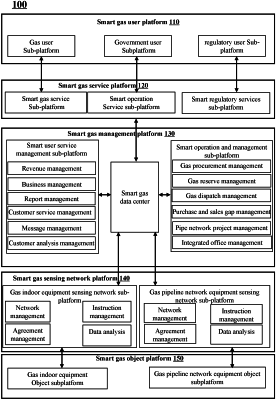| CPC G06Q 10/06311 (2013.01) | 6 Claims |

|
1. A method for managing smart gas work order implementation, wherein the method is performed by an Internet of Things system for managing smart gas work order implementation, the Internet of Things system for managing smart gas work order implementation includes a smart gas user platform, a smart gas service platform, a smart gas management platform, a smart gas object platform, and a smart gas sensing network platform, the smart gas management platform includes a processor and a database, the database includes one or more of a library of work orders to be assigned, a work order database to be implemented, a historical work order database, and a vector database, the smart gas object platform includes a gas indoor equipment object sub-platform and a gas pipeline network equipment object sub-platform, the gas indoor equipment object sub-platform is configured as various types of gas indoor equipment for gas users, the gas pipeline network equipment object sub-platform is configured as various types of gas pipeline network equipment and monitoring equipment, and the method comprises:
obtaining, the smart gas sensing network platform, data related to gas equipment by issuing instructions to through the smart gas management platform;
receiving, by the smart gas management platform, the data related to the gas equipment transmitted from the smart gas sensing network platform;
obtaining, by the smart gas management platform, gas work order information and user information from the library of work orders to be assigned; wherein the gas work order information includes at least one of work order type, fault type, gas availability, and environmental condition at a fault point, and the user information includes at least one of gas usage, a number of permanent residents, and gas-using equipment condition;
determining, by the smart gas management platform, an implementation priority of gas work order based on the gas work order information and the user information; wherein the determining an implementation priority of gas work order based on the gas work order information and the user information includes:
determining an urgency of the gas work order based on the gas work order information and the user information; the urgency of the gas work order including usage urgency and safety urgency; wherein the determining an urgency of the gas work order based on the gas work order information and the user information includes:
determining the safety urgency by a first assessment manner based on the gas work order information; wherein the first assessment manner includes:
predicting a safety assessment value by a safety assessment model based on the fault type and the environmental condition at the fault point;
determining the safety urgency based on the safety assessment value; wherein the safety assessment model is obtained by training an initial safety assessment model based on a large number of first training samples with labels, the first training samples are a large number of different sample fault types, sample environment condition at fault points, sample target duration, a label is a sample safety assessment value at an end of a corresponding sample target duration, and the training an initial safety assessment model includes:
inputting the large number of first training samples with labels into the initial safety assessment model;
constructing a loss function from the labels and results of the initial safety assessment model;
updating parameters of the initial safety assessment model iteratively based on the loss function; and
in response to determining that a preset condition is satisfied, completing the training of the initial safety assessment model, and obtaining a trained safety assessment model;
determining the usage urgency by a second assessment manner based on the user information; and
determining the urgency based on the safety urgency and the usage urgency;
determining the implementation priority by ladder segmentation based on the urgency, wherein the ladder segmentation is related to a loss of value of the gas work order in historical data, the loss of value including at least one of loss of gas use and loss of value of user review;
determining an implementation scheduling scheme for the gas work order based on the implementation priority, the implementation scheduling scheme including a target implementation time;
matching a pre-processing scheme for the gas work order via a vector database based on at least one of the work order type, the fault type, and the implementation scheduling scheme, the pre-processing scheme including pre-processing content and pre-processing time; and
executing the pre-processing scheme at the pre-processing time and pushing a pre-processing result to a work terminal of an implementer through the smart gas user platform.
|